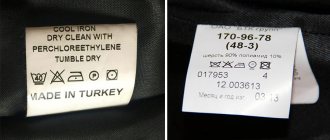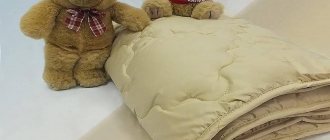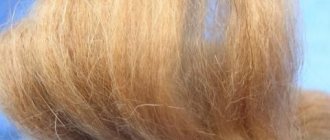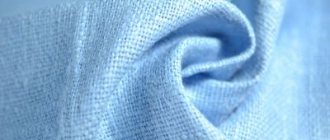How and where to store wool coats
To preserve the primary beauty of woolen clothing, you first need to pay attention to proper storage. To do this, you need appropriate hangers that are exactly the right size. Otherwise, the product may lose its shape and fit. It is also important to remember to remove the contents from your pockets. There should be nothing in your coat pockets. In terms of space, it is best to store wool clothing in a cool and ventilated area. In summer, it is recommended to use a storage case, hanging it in a dark, cool closet. But under no circumstances should you hang a woolen item in a cramped closet. There should be enough space.
Features of the procedure depending on the material
Each material behaves differently during the washing process. This must be taken into account and all requirements must be followed. First of all, you need to pay attention to the choice of detergent. The universal washing powder familiar to everyone is not suitable here. It is too aggressive for coat fabrics. It makes the fibers coarse, inelastic, promotes their shrinkage and generally spoils the appearance of the product.
By the way, before, when good detergents for coats were unavailable, housewives used shampoo . It is much softer than powder, and its liquid consistency ensures that the detergent is completely diluted in water (unlike powder detergents, particles of which may be present in the water). Detergents for coats with a gel consistency are still deservedly popular today. Today on sale you can find high-quality compositions specifically for washing coats at home, and the packaging will indicate what materials it is for, and therefore the choice will not be difficult.
The next feature of washing a coat is the procedure itself, more precisely, its type - machine or manual. The latter is considered much softer and more gentle, but sometimes you can trust coats and household appliances.
How to properly wash a coat in an automatic washing machine? This requires a delicate wash function. If there is no such program in the machine, then you need to set the necessary parameters (temperature). It’s better to turn off the spin function altogether, but an additional rinse, on the contrary, won’t hurt.
For coats made of wool and drape, it is recommended to additionally use conditioner (special for such products). It will preserve the elasticity and softness of wool fabric.
How to wash a drape coat
Products made from drape are more susceptible to shrinkage than others, and therefore, if possible, it is better to limit cleaning to a special damp brush. Is it possible to wash a drape coat at all?
Such products can only be washed by hand . Moreover, if there are overhead elements on things, then it is advisable to limit yourself to soaking altogether. That is, the washing process will be minimal - soaking the coat in a detergent solution in a bathtub or basin, wiping with a brush along the entire length, hand-squeezing and drying. The whole process takes no more than 15 minutes. Failure to comply with these requirements, as well as exceeding the temperature norm, will lead to peeling of the overlay elements and loss of the product’s shape. As for detergents, wool formulations are suitable. This should be indicated on the packaging.
Finally, it is better not to try to wash a drape coat yourself at home, especially with overlays, but to entrust this problem to professionals.
How to wash a cashmere coat
How to properly wash a cashmere coat? Like drape, it is better to wash cashmere coats at home only by hand, and these products do not like machine washing. After this process, the material rolls up, shrinks, and changes color (turns pale). The hand washing process is very similar to that for a drape coat. Water is poured into the bath and a special detergent is dissolved. It is even advisable to foam it, this will facilitate faster penetration of the active components into the fabric fibers and reduce washing time.
The washing movements should resemble rinsing, that is, the product is moved from side to side in the water. You need to do this for 15-20 minutes. After rinsing, the product is dried not by twisting, but by crumpling it in a towel.
It is better to first remove the shiny areas (collar and sleeves) with a brush dipped in a detergent solution. You should not act intensively, but very carefully.
How to wash a wool coat
How to wash a wool coat at home? Some wool coats can be machine washed on a delicate cycle if the manufacturer specifies this option. It’s better to turn off the spin cycle, but this is how you can get rid of excess water in the fabrics of your coat. You need to leave the coat in the washing machine for a while (about an hour), and then the excess water will go away on its own. Hand washing a wool coat at home is identical to the previous methods.
We recommend reading: “How to wash a wool sweater correctly”
How to wash synthetic and polyester coats
Is it possible to wash a coat in an automatic washing machine? Synthetics and polyester are not so sensitive, and therefore the requirements for them are a little softer. They tolerate temperatures within 40 degrees very well, and light spinning is also not prohibited. Finally, other detergents can be used for artificial fabrics. After washing, the product is wrung out and shaken slightly to get rid of any wrinkles that have appeared.
How to dry a coat after washing
You should think about drying in advance so that you don’t have to run around looking for the necessary items. So, an old and at the same time very reliable way of drying a washed coat is to lay it horizontally on a special drying rack or rack above the bathtub. You can place a towel or sheet underneath to prevent the fabric from stretching. When most of the moisture has subsided, you can move the product to another room for final drying.
Important! No heating devices - hair dryer, ten, heated coat hanger - can be used!
The room itself must also have certain requirements. It should not be wet, it should not be exposed to direct sunlight, and good ventilation of the space will be an additional advantage and will help reduce the drying time of the coat.
A great way to remove excess moisture from a coat immediately after washing.
Incorrect drying (in the usual way, on a rope) will lead to stretching of the product. It is considered relatively safe to dry coats made of artificial materials in a suspended (vertical) state.
The nuances of washing a winter coat with filling
A winter coat with filling is nothing more than a down jacket, only instead of the classic bird down, the filling can be various materials. You can wash the coat in a washing machine or by hand (read the product label first). The preparatory processes here are identical to those used when washing coats made from other fabrics. It is advisable to wash the dirtiest stains in advance and only then proceed with general washing.
How to wash a coat so that the filling does not become crumpled at the end of the process? There are several tricks, the simplest is to put 2-3 tennis balls with the coat.
To dry, the product is turned inside out and hung up. Water may still drain from it for some time. Subsequently, it is allowed to occasionally squeeze out the wettest areas to speed up the process. Once completely dry, the lumps of filler are hand-beaten and distributed evenly.
Washing a coat correctly at home without losing the beauty of the product is not an easy task. But if you follow the recommendations, the result can exceed all expectations.
Video
Write in the comments how this process works for you, and also share your useful tips and experiences!
Share this page with your friends!
Cleaning and washing wool coats
Coats made from natural wool must be cleaned with a special clothes brush. As for washing, woolen fabric does not like it very much. Experts recommend taking your coat to the dry cleaner if it is heavily soiled. But there are also washing methods that many people use. The most important thing is to carefully select the detergent and do not forget to check the reaction from it on a small piece of coat fabric. Of course, you should try it on the inside of the product. This check will make sure that the color of the fabric will not change under the influence of the selected detergent. A woolen coat should be dried flat, away from the radiator.
Removing stains
If several separate stains appear on your coat, you can get rid of them locally. There are several effective methods:
- Dissolve a small amount of shampoo or dish soap in warm water. Moisten a clean cloth or cotton swab with the resulting solution and apply to the stain. Wait until the solution is completely absorbed and wipe the surface from the edges to the center of the stain. If necessary, repeat the procedure. Then the soap solution with any remaining dirt is carefully washed with a cloth moistened with running water. Blot any remaining moisture with a clean terry towel and leave the product to dry naturally.
- You can get rid of fresh stains using talcum powder or regular potato starch. Sprinkle it thickly on the problem area and after an hour, simply shake out the remaining powder that has absorbed grease and dirt.
- A light woolen coat is cleaned of dirt with the following solution: 4 teaspoons of ammonia mixed with a teaspoon of table salt. A cotton pad is moistened in the resulting solution and used to wipe the surface. Wash off the mixture with a soft damp cloth.
Another proven method of removing stains is 3 percent vinegar, which is used to treat the contaminated area. After 30 minutes, it is washed off with running warm water along with the dirt.
How to remove a stain correctly
Stains on woolen fabrics should be removed from the edge to the middle. This will prevent the formation of a so-called “halo” - a leak. And it is advisable to remove stains fresh, both grease and oil. To remove the stain, you need to take a warm iron and several ordinary colorless paper napkins. Having applied napkins to both the front and the inside to form a layer, you should iron the fabric with a warm iron. You can remove stains in another way. For example, wipe with a swab dipped in a warm solution of ammonia (1 tablespoon) and detergent (1 tablespoon). You need to dilute alcohol and detergent in 200 grams of warm water. It is better to clean greasy stains remaining on the collar using a cotton swab moistened with a solution of salt and ammonia. For a glass of water you need 1 tbsp. a spoonful of salt and 1 teaspoon of ammonia.
When buying a wool coat, you should choose models with special impregnation that will protect against dirt and moisture. A good choice would be fabric with Storm System and Rain Systems protection. Such woolen fabric is reliably protected, and therefore is not afraid of either weather conditions or possible contamination. You won’t have to take care of it for a long time or often. Impregnated wool does not absorb moisture and dust, maintaining a fresh look for a long time. This fabric tolerates dry cleaning well. Therefore, if you do get your coat dirty, you can solve this problem very quickly.
Cashmere coat
A very thin, warm, soft material made from the fluff of Tibetan goats (sometimes from merino sheep) - cashmere is one of the favorite materials of women.
But having many advantages, cashmere is very susceptible to environmental influences and requires care. Like any coat, it needs to be cleaned before storing it.
The label on the coat usually indicates whether the item can be washed or whether you will have to use dry cleaning services. Usually washing is allowed even using an automatic machine, but only with a special gentle mode.
But it is still advisable to wash cashmere items by hand using products specially designed for delicate or woolen fabrics.
A well-foamed soap solution is applied first to the most contaminated areas, and then to the rest of the surface. Use a soft-bristled brush or sponge to scrub away any dirt on the collar, sleeves, and around pockets. Then wash the foam off the product using the shower. The water should be about thirty degrees Celsius.
Cashmere is easily deformed, so wringing a cashmere coat is PROHIBITED. Place the coat on wide hangers, let the water drain, and then lay the coat on a terry sheet on a horizontal surface. After some time, change the sheet. Before drying, be sure to thoroughly straighten out all wrinkles and wrinkles. You cannot iron a cashmere coat.
- Stains from cashmere are removed just like from other woolen products. Grease - using a napkin soaked in purified gasoline. Sweat – with a cotton pad soaked in ammonia. For other stains, use a cloth with a mixture of glycerin and ammonia applied. Ammonia and glycerin are mixed in a one to one ratio.
- You can remove unpleasant odor from a product with baking soda. Lay out the coat, sprinkle baking soda on it, leave for a long time (about twelve hours) and then remove the soda with a brush. Baking soda will perfectly absorb all unwanted odors. But still try not to be in heavily smoky rooms or other places with pungent odors.
Is there a way to protect a long coat from splashes?
During the off-season and thaws, you need to be especially careful. Firstly, try to stay away from the roadway, otherwise some driver will not have time to slow down and will splash you with a puddle. Secondly, there is a much less obvious danger - small splashes that fly from under your feet and remain on the back of your trousers and the hem of your coat. Try not to reach cruising speeds to reduce the scale of the disaster. You can also treat the bottom with water-repellent impregnation - this applies to products made of suede or leather. Well, you already know what to do if dirt still sticks to the thing.
Water repellent, Hydrop, RUB 2,240. on lamoda.ru
Caring for a drape coat
The drape coat is easy to care for, but:
- it cannot be washed in a washing machine. Dirt can be removed by hand, with soap suds, or using wool detergent or stain remover.
- It is better to dry your coat in the fresh air, however, given the peculiarities of winter weather, a glazed balcony or loggia will do.
- small “garbage” can be removed from the fabric with a sticky roller, dry dirt can be removed with a stiff brush.
- Like any other product made of woolen fabric, a drape coat should not be left wet on a hanger.
Read also: Getting rid of stains on coats
Can I wash my coat myself?
To answer this question, you need to look at the label. If the recommendations only include dry cleaning, then it’s not worth the risk. Otherwise, follow all the instructions - you may think that 40 degrees is not much different from 30, but then be prepared to take out a thing a couple of sizes smaller from the machine. If there are no identifying marks on the coat (for example, this often happens with clothes from vintage stores), then it is better not to test it for durability.
View gallery
14 photos
Chevron
Caring for a tweed coat
Caring for a tweed coat is very easy. Just a few tips to remember:
- Washing - hand, without soaking and only in emergency cases;
- Machine washable, but at low water temperature;
- The coat should be dried strictly in a horizontal position, and ironed only from the inside out and through damp gauze;
- To dry clean, you will need a medium-hard brush.
Now you know how to care for your coat in winter, during its active use. Save our advice and be fully armed. Perhaps they will help you out at a crucial moment.
Caring for a cashmere coat
A cashmere coat is an expensive pleasure, and therefore it is your duty to take care of it. Cashmere itself is a very delicate and even “capricious” material, and therefore it should be treated very carefully.
If you are caught in heavy snowfall or heavy rain, you must remember that the coat cannot remain damp/wet for long. Isn't it too wet? Then you just need to dry it by hanging it on a hanger. If the coat is saturated with water, you must first place it on a terry towel, which will absorb the moisture, after which it can be hung on the trempel.
Please note: cashmere fabric can stretch greatly under the weight of water, and therefore a wet coat should not be placed vertically immediately.
Is your coat pretty dirty (splashes of dirt/slush flew at you from under the wheels of a passing car, you got dirty with coffee, wine, or “planted” a stain of any other origin, wiped the outer wall of the minibus while entering it)? The situation must be corrected immediately. The simplest advice that can be given in such cases is to turn to dry cleaning services. But, if this is not possible, then you should try to solve the problem yourself.
A cashmere coat can be washed, but depending on the percentage of pure wool in the fabric, some features of this process stand out. For example, there are cashmere coats for which washing is absolutely contraindicated, but there are fabrics that can be washed: hand or machine in a delicate mode at a temperature of 30 degrees.
Read also: Rules for caring for winter clothes?
Pay attention to the label and be aware: after machine washing, the coat may “shrink,” not to mention the formation of lint lumps on it.
Hand washing requires compliance with some rules:
- the water should be warm;
- powder or soap - completely dissolved;
- soaking period – several hours;
- You can’t rub the coat, you can lightly move your hands over it;
- After washing, the product must be rinsed 3-4 times in cold water.
Under no circumstances should you rub cashmere, as it will roll up in no time.
By the way, pilling can occur not only after cleaning or washing the coat, but also after the friction that it will have to endure after your trip in cramped public transport.
It’s easier to remove unsightly lumps if you have a special machine at hand that carefully cuts them off. But, you can get by with simple nail scissors, although in this case the process may take a long time.
After cleaning the fabric from pellets, it should be smoothed with the palm of your hand or using a soft brush.
We wash away small stains
Getting rid of small stains on woolen clothes is not difficult. You should not try to remove such stains with purified gasoline.
Many online publications recommend this method, but we strongly recommend that you not use it because... you will simply ruin your expensive item.
Oily stains can be easily removed with talc. Sprinkle the area where the stain is located generously and leave it for 8-12 hours. After this time, clean the clothes with a brush.
If the fat is very deeply ingrained, repeat the procedure 2-3 times.
Fresh stains from oil or other similar grease can be removed using a warm iron. It is necessary to place 3-5 layers of paper napkins on the area where the stain is located and iron it well.
Coffee or tea stains on clothes can be removed using a cotton swab. All you need to do is soak the tampon in half a teaspoon of 10% ammonia and two teaspoons of glycerin. Next, you need to wipe the area where the stain is located until it is removed.
You can get rid of recent beer stains on a white item using hydrogen peroxide. For removing stains from woolen fabrics, pure alcohol diluted one to one with table vinegar is best suited.










